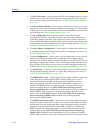
Bridging Basics 4-5
Bridging
For data that is restricted to the Token Ring networks available from the SR-TB
bridgeÕs front panel, the bridging method used is user-conÞgurable via local
management to be Source Route-only (bridged packets must include RIF
information and will be source routed; no transparent bridging is enabled),
Source Route-Transparent (bridging method will be determined by whether the
RII bit is set), or Transparent only (no source routed packets will be bridged).
Remote management of these interfaces is based upon their current mode (as set
through local management).
For data that will ultimately be sent across an FDDI interface to an ATM, Ethernet,
FDDI, or another Token Ring segment, the Routing Information Field will be
stripped from the packet so the packet can be transparently bridged onto Ethernet
or FDDI media; however, the RIF information as well as the source address of the
packet is stored in a RIF cache of the SR-TB bridge. When data is returned to that
source address, the SR-TB bridge can look up the address information in its RIF
cache, append the proper Routing Information onto the packet, and then forward
the data to the Token Ring segment.
The RIF cache is a software table that can store up to 8192 entries. An SR-TB
bridge updates its RIF cache much like a Transparent bridge dynamically updates
its Filtering Database: it learns new address information by listening to incoming
packets on each port, saves that information to an Address Database, andÑif the
address was learned to be Source-Route capableÑupdates routing information
for that source address in the RIF cache. Every time a packet arrives from an FDDI
interface for a MAC address that is communicating through the SR-TB bridgeÕs
front panel, the RIF cache table is searched for an address/RIF match.
There are conÞguration issues when a Token Ring module receives a packet from
an FDDI interface for a destination address that is unknown, and not in its
Address Database or RIF cache. You must conÞgure your SR-TB bridge to treat
incoming packets with an unknown destination address as either a Source Route
or Transparently bridged packet (since Token Ring end stations attached to the
module may or may not support Source Routing).
If the bridge is conÞgured to treat an incoming packet with unknown addresses as
a Source Routed frame, it will forward it using either STE or ARE frames. If the
bridge is conÞgured to treat an incoming packet with an unknown destination as
a Transparently bridged frame, it simply forwards the frame.
After a packet with a previously unknown destination has been bridged
successfully, and communication begins between the two end nodes, the RIF
cache will be updated and packets will be translated as described previously.


















